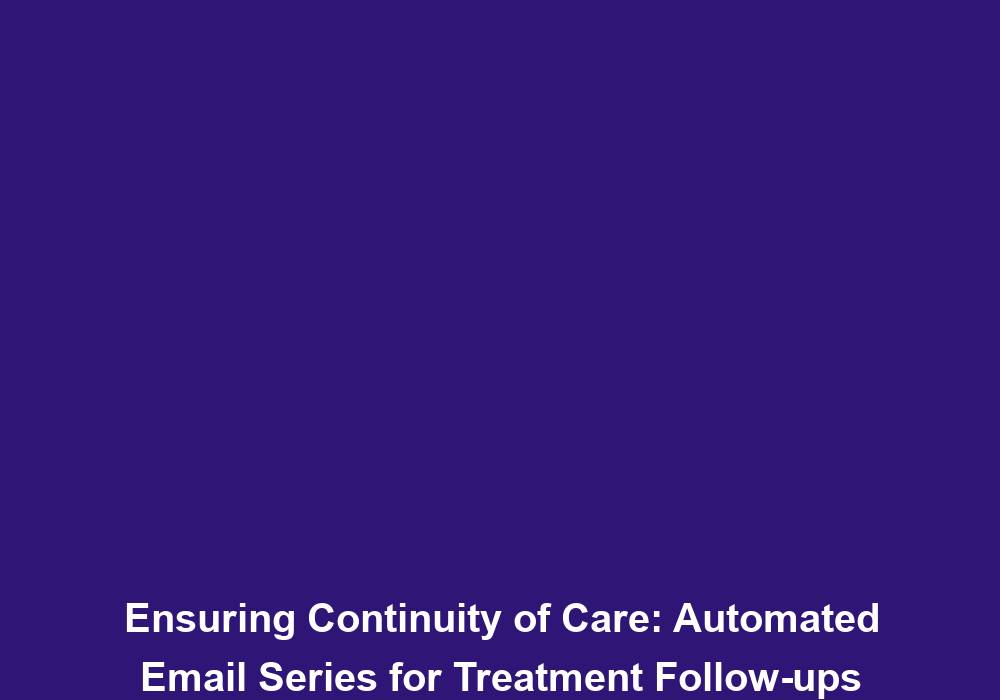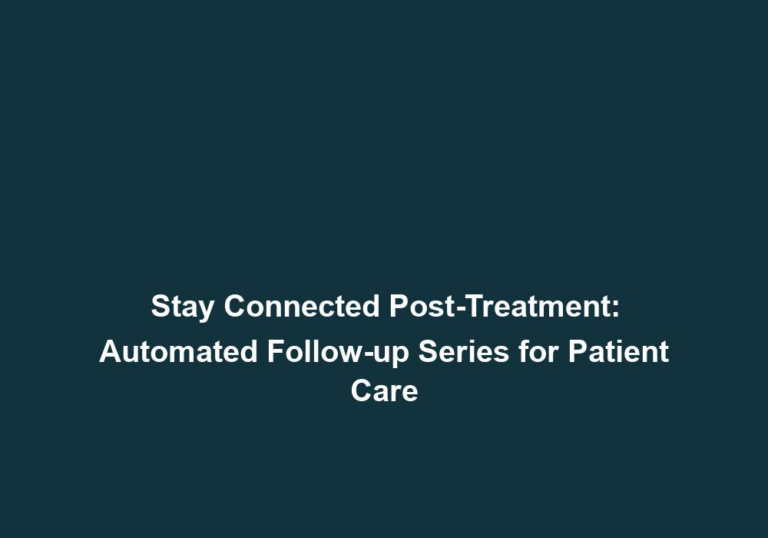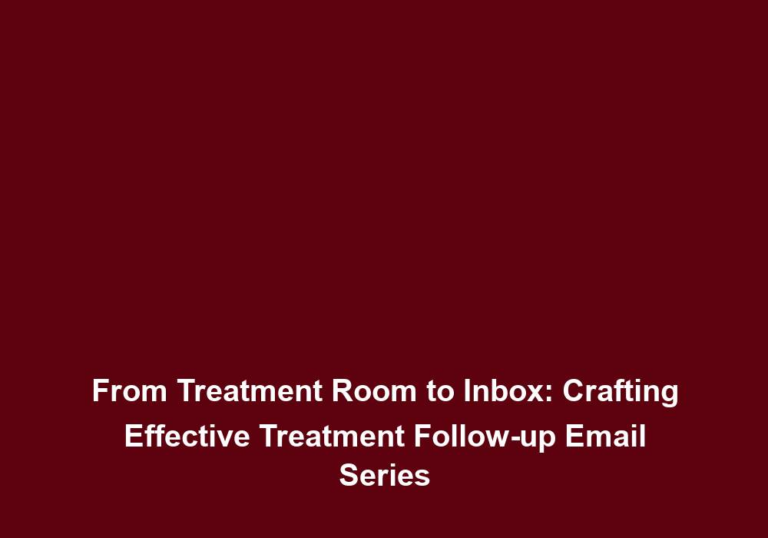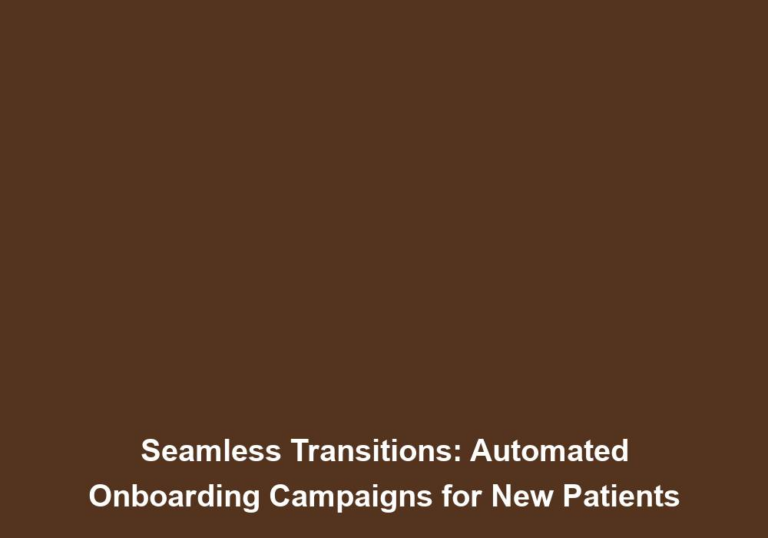Ensuring Continuity of Care: Automated Email Series for Treatment Follow-ups
In the fast-paced world of healthcare, maintaining continuity of care is critical to ensure patients receive the necessary support and follow-up treatment. One effective way to achieve this is by implementing an automated email series specifically designed for treatment follow-ups. This article explores the importance of such an email series and provides guidance on creating an effective one.
Why is Continuity of Care Important?
Continuity of care refers to the seamless coordination and integration of healthcare services provided to patients over time. It ensures that healthcare providers have a comprehensive understanding of a patient’s medical history, enabling them to make informed decisions and provide personalized care. Continuity of care is especially important for individuals undergoing treatment, as it helps prevent gaps in care and improves patient outcomes.
The Role of Automated Email Series
An automated email series is a set of pre-scheduled emails that are automatically sent to patients at specific intervals. It serves as a valuable tool in ensuring continuity of care by keeping patients engaged, informed, and motivated throughout their treatment journey.
Benefits of an Automated Email Series for Treatment Follow-ups
-
Improved Patient Engagement: Sending regular follow-up emails keeps patients engaged and connected to their healthcare providers. It demonstrates a commitment to their well-being and encourages active participation in their own care.
- Patients are more likely to follow their treatment plans when they feel supported and engaged by their healthcare providers.
- Regular emails provide an opportunity to educate patients about their condition, treatment options, and self-care strategies.
-
Timely and Relevant Information: An automated email series allows healthcare providers to deliver timely and relevant information to patients. This can include reminders about upcoming appointments, medication instructions, lifestyle recommendations, and educational resources. By receiving this information at the right time, patients are more likely to adhere to their treatment plans.
- Reminders about upcoming appointments help patients stay organized and ensure they don’t miss important follow-up visits.
- Providing medication instructions and lifestyle recommendations through email allows patients to refer back to the information whenever needed.
-
Support and Encouragement: Treatment can be a challenging and emotionally draining process. An automated email series provides an opportunity to offer support and encouragement to patients, boosting their motivation and overall satisfaction with their healthcare experience.
- Personalized messages that acknowledge the patient’s progress and challenges can make them feel valued and supported.
- Sharing success stories and patient testimonials can inspire and motivate patients to continue their treatment journey.
-
Identification of Potential Issues: Regular communication through an email series enables healthcare providers to identify any potential issues or concerns that patients may have. By addressing these concerns promptly, healthcare providers can prevent complications and enhance patient safety.
- Patients may feel more comfortable expressing concerns or asking questions through email than during in-person visits.
- Identifying issues early on allows healthcare providers to adjust treatment plans or provide additional support as needed.
-
Efficient Communication: Automated emails streamline communication between healthcare providers and patients. They eliminate the need for manual follow-up calls or visits, saving both time and resources. This efficiency allows healthcare providers to focus on delivering quality care.
- Automated emails can be sent to a large number of patients simultaneously, ensuring consistent communication without overwhelming the healthcare staff.
- Patients can access important information and resources at their convenience, reducing the need for additional phone calls or visits.
Designing an Effective Automated Email Series
Creating an effective automated email series for treatment follow-ups requires careful planning and consideration. Here are some key steps to guide you through the process:
1. Define the Objectives
Before starting the email series, clearly define the objectives you want to achieve. These may include improving medication adherence, providing educational content, or monitoring patient progress. Having well-defined objectives will help guide the content and structure of your emails.
- Identify specific goals for each email in the series, such as educating patients about potential side effects or encouraging lifestyle changes.
- Align the objectives with the overall treatment plan and desired patient outcomes.
2. Segment Your Audience
Segmenting your audience based on their specific treatment needs and preferences allows for more personalized and targeted communication. Consider factors such as diagnosis, treatment stage, age, and previous interactions with your healthcare organization when segmenting your audience.
- Develop patient profiles based on demographic information, medical history, and treatment progress.
- Tailor the content and tone of the emails to resonate with each segment of the audience.
3. Determine Email Frequency and Timing
Decide on the appropriate frequency and timing for your emails. This will depend on the nature of the treatment, patient preferences, and the resources available to your healthcare organization. Strive for a balance between staying in touch and not overwhelming patients with too many emails.
- Consider the treatment duration and the need for ongoing support when determining the email frequency.
- Test different timings to determine when patients are most likely to engage with the emails.
4. Craft Compelling Content
Create content that is informative, engaging, and easy to understand. Use a conversational tone and avoid medical jargon or technical terms. Consider including a mix of educational resources, success stories, patient testimonials, and tips for managing treatment-related challenges.
- Include relevant statistics and research findings to validate the information provided in the emails.
- Use storytelling techniques to make the content relatable and memorable for patients.
5. Personalize Emails
Personalization is key to ensuring the emails resonate with each individual patient. Address recipients by their first name and tailor the content to their specific treatment needs. Use dynamic content and personalized recommendations based on their treatment milestones or progress.
- Use data from patient records and previous interactions to customize the emails.
- Incorporate patient feedback and preferences into the email content to enhance personalization.
6. Monitor and Evaluate
Regularly monitor the performance of your email series to evaluate its effectiveness. Track metrics such as open rates, click-through rates, and patient feedback. Use this data to refine your email content and optimize the series for better patient engagement.
- Analyze the open and click-through rates to assess the effectiveness of the subject lines and call-to-action buttons.
- Solicit patient feedback through surveys or direct communication to gather insights for improvement.
Conclusion
An automated email series for treatment follow-ups plays a vital role in ensuring continuity of care by keeping patients engaged, informed, and motivated. By following the steps outlined in this article, healthcare providers can create an effective email series that delivers timely information, support, and personalized care to patients. Embrace the power of automated emails to enhance the patient experience and improve treatment outcomes.






